READY TO GET STARTED?
REQUEST A FREE ESTIMATE
Fill out the form below or call (888) 466-7849 for a free, no-obligation estimate.
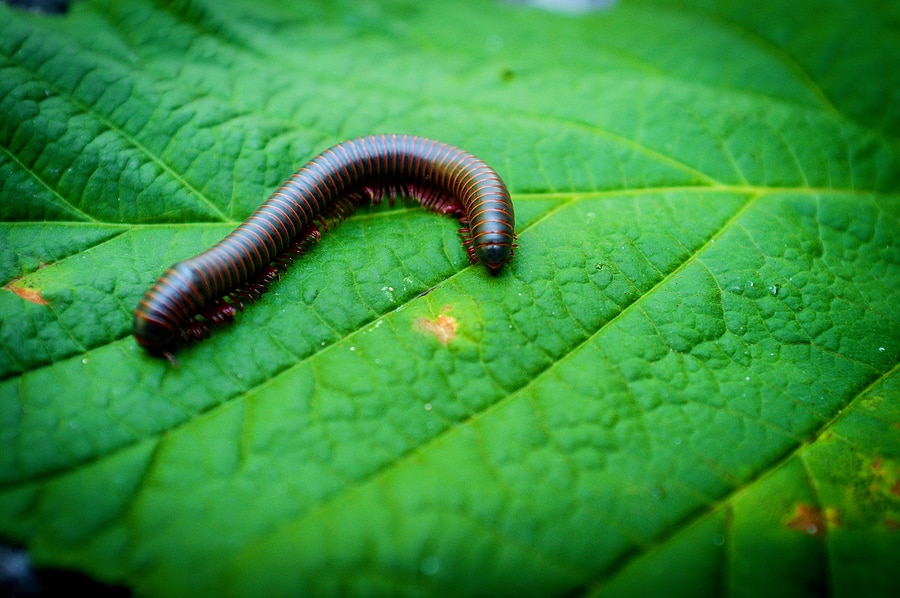
Millipedes are common pests that can be found just about anywhere in the United States. Most of the time they can be found outside under leaves, mulch, compost, and rocks, although occasionally they will come indoors – in search of water during droughts or in search of shelter after heavy rains. They can usually be found infesting basements, garages, and crawlspaces. If you find a millipede in your home, there’s a good chance they are breeding somewhere on your lawn.
Millipedes are decomposers with their diet primarily consisting of damp, decaying plant material. Because of this, they are quite beneficial to have in your garden. Millipedes are harmless to humans but they can become a nuisance if they are present in large numbers. Prevention is the best start to millipede control. Keep millipedes away from your home with these millipede prevention tips.
What attracts millipedes is moisture, especially in crawlspaces and around foundations. Keep gutters clear and in good repair. Consider installing gutter guards to help prevent clogs. Make sure downspouts are pointed away from foundations and use splash blocks to keep water away from foundation walls. Consider installing tiles or drains or sloping the ground so water drains away from foundations. Repair any leaky pipes, appliances, or faucets. Reduce the humidity in your crawlspace and basement with dehumidifiers, sump pumps, or soil covers.
If there is nowhere for millipedes to breed or hide, they can’t get into your home. Keep millipedes out by removing mulch, leaves, grass clippings, boards, woodpiles, rocks, boxes, etc. from your yard, especially if they are near foundations. If you are unable to remove them completely, try to elevate them off the ground. Try not to overmulch your flowerbeds.
Millipedes thrive in the moist layer of thatch that can accumulate on lawns. Keep your grass mowed short and dethatch the lawn as this will make it less appealing to millipedes. Try not to overwater your lawn. Don’t water at night since there is no sun to help evaporate the moisture.
Millipedes can get into your home through cracks in the exterior. Seal any cracks or openings in the outside foundation. Use thresholds or door sweeps on all exterior doors. Caulk the outer edges of the thresholds. Seal any expansion joints where sunrooms, patios, and sidewalks are next to foundations. Seal any expansion joints or gaps at the bottom of basement walls.
Millipedes can only survive for a few days once they get inside your home. The conditions indoors are too dry for them to be able to live long periods of time. The infestation will be short lived and eventually they will die off. Once this happens, you can sweep them up with a broom or vacuum them up.
While millipedes don’t cause damage to homes and aren’t harmful to humans, they can become quite a nuisance when they infest in large numbers. If you have a problem with millipedes or any other pests, contact a professional pest control company who can provide you with the most up-to-date prevention and treatment techniques.
What to Know About Fleas & Ticks
Commercial Mosquito Control: A No Spray Way for Your Business
Carpenter Ants: The Silent Destroyers
Make Checking The Bed Bug Registry Part of Your Spring Break Plans
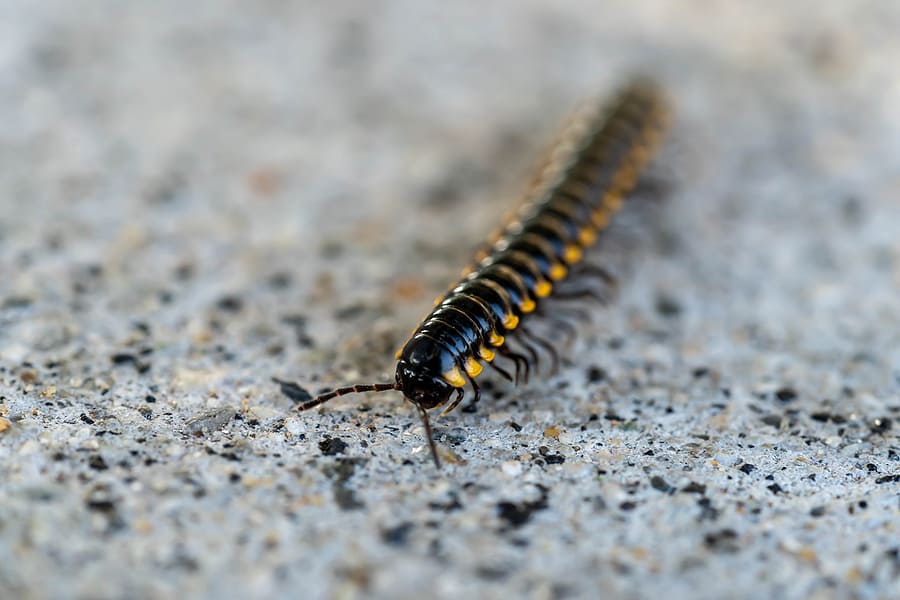
Millipedes are long, wormlike animals that are also referred to as worms, wireworms, and armyworms. While often mistaken for centipedes, millipedes are smaller (1 to 1-1/4 inches in length) with dark brown coloring and shiny, hard shells. They have long cylindrical bodies and have a habit of curling into a ball when they are disturbed. While the name millipede might imply they have thousands of legs, in reality they typically have 4 legs per body segment and at least 60 legs total, although some species can have up to 160 legs. Millipedes are harmless to humans as they cannot sting or bite. They also do not feed on plants or wooden structures. What they do feed on is decaying plant material and prefer damp, moist environments where they thrive. They are often found under leaves, plant debris, mulch, pine needles and other similar habitats.
While there is no set millipede season, they do go on mass migrations twice per year – once in the spring and once in the fall. These usually occur on warm, humid nights where they will emerge by the hundreds. Millipedes are outdoor pests so finding them inside your home means they have wandered in by mistake. In fact, millipedes cannot reproduce indoors. When these pests do make their way indoors, they are often found in garages and basements. Millipedes are nocturnal when they wander out of their hiding places roaming aimlessly. They eventually crawl back into holes or cracks (oftentimes in our homes) to escape the dryness of the impending daytime. They can often be found hiding under the edge of the garage door, in cracks along the exterior of your home, in sidewalk or driveway cracks, and in the gaps of your foundation.
Although millipedes are harmless, they can become a nuisance when they make their way into your home en masse. While there is no definitive millipede control method, the best practice is to try and keep them outdoors as best as possible. Because they often wander in through cracks and gaps, make sure these and other entry points around doors, windows, and foundations are sealed. They feed on organic material so keeping mulch, pine needles, and dead leaves away from your home will also help. Ensure gutters are not clogged and downspouts are angled away from foundations as this dampness will attract them in droves. Using insecticides on millipedes indoors is usually considered unnecessary as they will die in a short period of time due to lack of moisture. The best option to get rid of them indoors is to sweep or vacuum them up and discard them. Once the cold weather hits, they will become dormant… at least until springtime rolls around again!
If you have a problem with millipedes or any other household pests, contact your local pest control company for a free analysis.
Spring Cleaning to Keep Pests Out
Termite Control: Protecting Your Home From Termite Damage
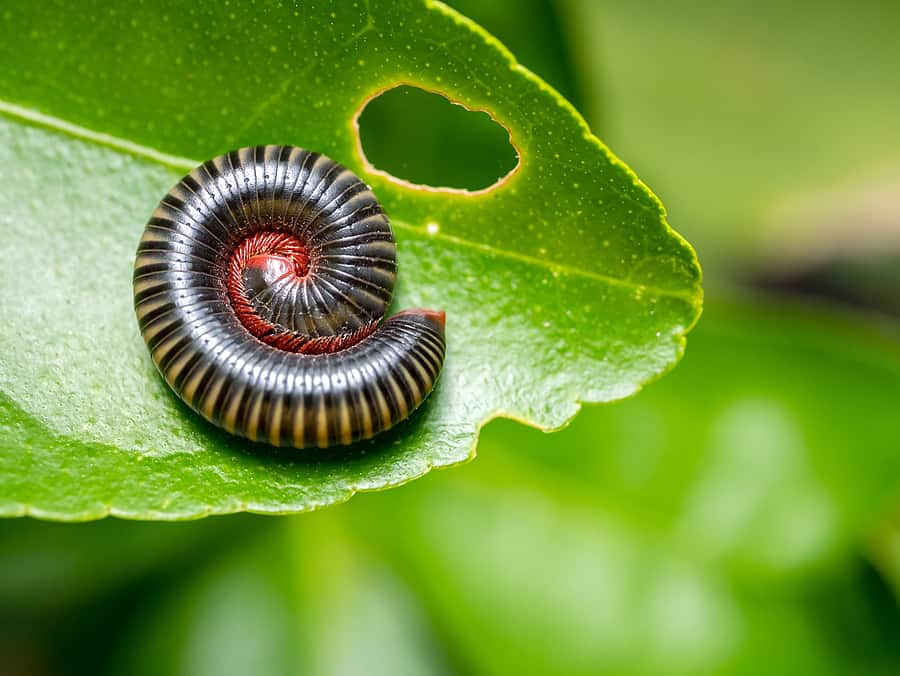
Millipedes are common occasional pests that are found throughout the United States. While they typically live outdoors under leaves, mulch, compost, rocks, etc, they will come indoors for two reasons: in search of water during droughts or in search of shelter after heavy rains. They are often found infesting basements, garages, and crawlspaces. If you spot millipedes in your house, it is highly likely that they are breeding somewhere in your lawn.
Millipedes are decomposers meaning their diet primarily consists of damp, decaying plant material. Because of this, they are quite beneficial to have in your garden. While they are harmless to humans, millipedes can become a nuisance if they infest your home in large numbers. Prevention is the best method of millipede control. Here are some tips you need to know about how to keep millipedes away from your home.
If there is nowhere for millipedes to hide or breed then they can’t infest your home. Prevent millipedes by removing mulch, leaves, grass clippings, boards, woodpiles, rocks, boxes, etc. from your yard, especially if they are near foundations. If you are unable to remove them completely, try to elevate them off the ground. Try not to overmulch your flowerbeds.
What attracts millipedes is moisture, especially in crawlspaces and around foundations. Make sure your gutters are clear and properly functioning. Consider installing gutter guards to help prevent clogs. Make sure downspouts are pointed away from foundations and use splash blocks to keep water away from foundation walls. Consider installing tiles or drains or sloping the ground so water drains away from foundations. Repair any leaky pipes, appliances, or faucets. Reduce the humidity in your crawlspace and basement with dehumidifiers, sump pumps, or soil covers.
Millipedes thrive in the moist layer of thatch that can accumulate on unkempt lawns. Keep your grass mowed short and dethatch the lawn as this will make it less appealing to millipedes. Try not to overwater your lawn. Don’t water your lawn at night as there is no sun to help evaporate the moisture.
Millipedes can enter your home through cracks in the exterior of your home or foundation. Seal any cracks or openings in the outside foundation. Use thresholds or door sweeps on all exterior doors. Caulk the outer edges of the thresholds. Seal any expansion joints where sunrooms, patios, and sidewalks are next to foundations. Seal any expansion joints or gaps at the bottom of basement walls.
Millipedes can only survive for a few days once they get inside your home. The conditions indoors are too dry for them to be able to live long periods of time. The infestation will be short lived and eventually they will die off. Once this happens, you can sweep them up with a broom or vacuum them up.
While millipedes don’t cause damage to homes or to the health of humans, they can become quite a nuisance when they invade in large numbers. If you have a problem with millipedes or any other pests, contact a professional pest control company who can provide you with the most up-to-date prevention and treatment techniques.
Watch out for the Stinging Pests!
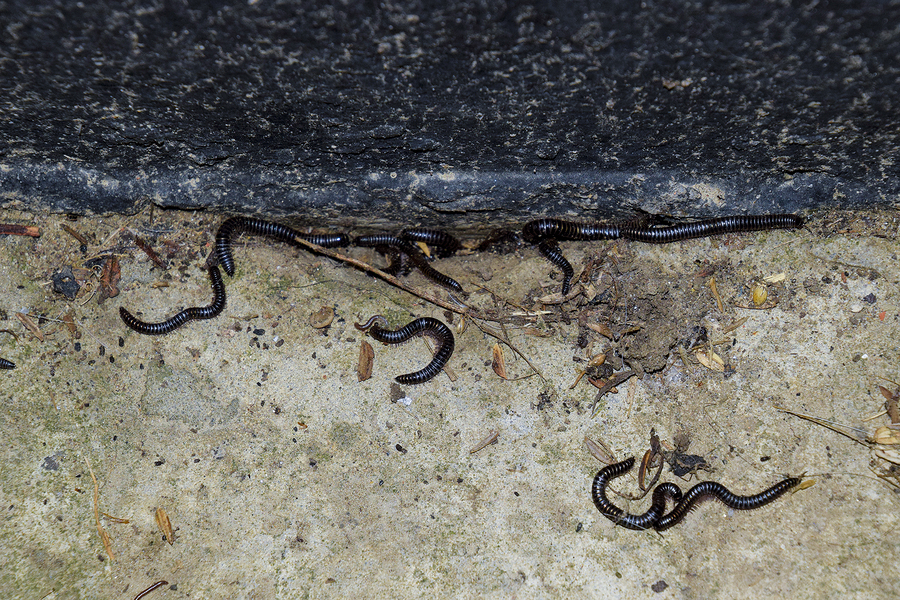
Seeing “thousand legger”, creepy-crawly, slithering, worm-like pests in mass amounts inside your home? You’re not alone. They’re called millipedes and millipedes in houses are common at certain times during the year, particularly after heavy rains, during drought, or when temperatures drop – all conditions that can make their outdoor habitats less comfortable. Once millipedes are in the house, they’ll search for shelter and a source of moisture – preferring damp areas such as basements, laundry rooms, and crawlspaces.
Millipedes are arthropods, not insects, that typically have hundreds of legs (not thousands as their nickname implies). Their size depends on the species but they usually range from 1/4 to 2 inches long with slender, round bodies – similar to worms.
Although creepy to some, millipedes are not dangerous or harmful to humans or pets. They don’t bite or sting, infest or damage wood, food or clothing – but they can release an unpleasant-smelling fluid if threatened that may cause skin irritation. If you come directly in contact with millipedes, rinse the affected area immediately after.
Millipedes feed on dead and decaying matter – anything that’s rotting, dead insects, vegetable matter – which is vital in the decomposition of plants and animals, an important step in the soil fertilization process. They will occasionally eat young plants but the damage is usually minimal.
Millipedes prefer to be outdoors and can be found in areas with a lot of moisture – under rocks, piles of wood, flowerpots, in leaf litter or grass clippings, in gardens and flowerbeds, under mulch – any hiding spot that’s damp and undisturbed. You’re more likely to see them at night, when they leave their habitats, crawling around on sidewalks, driveways, patios, etc.
When weather conditions aren’t ideal outdoors, millipedes can migrate into structures in large numbers via doorways, expansion joints, and/or wall voids. Once inside, millipedes will die quickly, especially if there is no abundant source of moisture. If you’re seeing millipedes inside frequently, it may be a sign that they are breeding outside around your home, or that you have moisture issues that need to be corrected.
The best way to prevent a millipede infestation is to eliminate debris and decaying matter from around your home and yard – especially around your home’s perimeter, and correct moisture issues. Repair leaking pipes or faucets, check to be sure lawn sprinklers are functioning properly, consider upgrading your gutters with a gutter guard system, and ensure basements or crawlspaces are adequately ventilated. One of the most effective methods to reduce moisture and improve overall home health is to enclose your crawlspace.
If you’re seeing millipedes inside, a quick fix is to use a vacuum to get rid of them. If you’re experiencing a millipede infestation, it could be a sign of other issues, and it’s recommended to get your home inspected by a pest control company that can identify and correct entry points, check for and make suggestions related to moisture problems, and get you on a routine pest control service – to prevents future millipede and other pest infestations. Request a free estimate now or call (888) 466-7849.
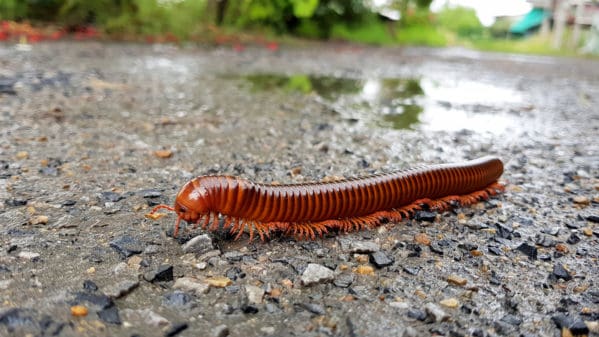
Millipedes are arthropods (not insects) that are commonly found in damp, moist locations. They feed on decaying organic matter. Millipedes will usually hide during the day and come out at night when the humidity is higher and dew is present on the ground. Millipedes are often mistaken for centipedes – they have elongated, worm-like bodies with 2 pairs of legs on each segment of their bodies. They are usually about 1 inch long with a hard, round, cylindrical body that is brown to black in color. When they are disturbed or dead they will curl into a spiral.
Finding a millipede in the house is not common. They cannot reproduce indoors and usually only come inside when there is a period of extreme wetness (during the rainy season) or in search of somewhere to overwinter (usually in late Fall). Millipedes are most commonly found in gardens but when they do come indoors they are usually found in the garage, basement, or the lowest level of the home. Millipedes that wander indoors typically die in a short amount of time because of the dryness.
If a millipede does get into your home, are they helpful or harmful? Should you be concerned? Millipedes are NOT harmful to humans. They do not feed on buildings, structures, or furnishings. They also cannot bite or sting. In fact, they can be beneficial in your compost pile as they help to break down the contents. They can cause damage to your garden by destroying seedlings or feeding on vegetables; however, there is no need to eliminate them unless they are causing damage to your plants.
While a millipede infestation is rare, there are things you can do to help prevent these pests from getting into your garden or home. Here are some tips on how to get rid of millipedes:
Take the Homework, Leave the Lice